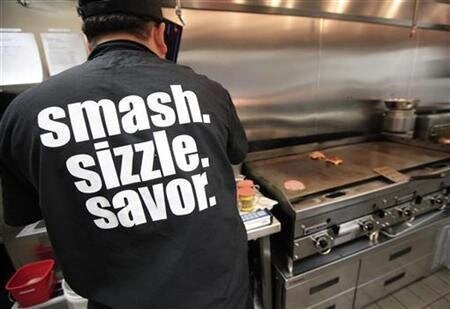
(Reuters - By Gary M. Stern) - As the fast-casual restaurant buzz whets appetites across the nation, the recipe for success is anyone's guess, from Five Guys Burger and Fries to Chipotle and Panera Bread.
But the quickly-expanding Smashburger chain appears to have got it: a model that translates well to different regions and customer bases.
"Consumers customize apps on their smart phones and they want their burger their way," says Ron Paul, president of Technomic, a Chicago, IL.-based restaurant consultant.
It's a sentiment espoused by Smashburger, the five-year-old conduit to a better burger.
Now with 143 locations in 25 states, Smashburger offers burgers freshly made from Angus beef, uniquely accessorized with diverse toppings, and the meal is brought fresh to the table by a server. Nothing is pre-cooked.
But the showpiece at Smashburger is how it adapts its product to local tastes.
In Denver, where it's headquartered, the Smashburger is garnished with mild green chilies and pepper jack cheese, just the way Coloradans prefer it. In Brooklyn, the Smashburger can be served like a Reuben sandwich replete with pastrami and Swiss cheese and served on a pretzel bun.
Dave Prokupek, CEO of Smashburger, says the market was screaming for better burger choices back when he started the company, despite spending $70 billion of the $100 billion market on McDonalds, Burger King and Wendy's.
"It was an a-ha moment," he said.
"The gap was creating a great tasting burger. It all starts with the food," Prokupek said.
Smashburger established 19 distribution centers to ensure quick food delivery. Expanding helps drive down its food costs, explained Prokupek.
And the burgers are actually smashed, hence the name.
"We take a half pound meatball, smash and flatten in, cook it fast for one to three minutes on the hot grill so it becomes caramelized and crisply seared. That helps keep the juices in," Prokupek said.
Despite the made-to-order burger, Prokupek says, "We still try to get diners in and out in 20 minutes." And the price is low: $8 to $10 gets you a decent meal.
At Smashburger 50 percent of the locations are company-owned and 50 percent franchised. It generated $53.5 million in revenue in 2011 up from $39.5 million in 2010, a nearly 26 percent rise in a tough economy.
But the other standout feature is there is no budget for TV or radio ads and it depends on social networking for promotion.
A two-person Facebook and social marketing team respond to consumer feedback.
Smashburger is growing because of several factors including developing a "better burger," Ron Paul said. .
Another factor has been its menu of chicken sandwiches, veggie burgers, salads, and even hot dogs. Functioning as a well-rounded restaurant more than the typical limited fast food menu makes it appeal to a wider audience, particularly those who count calories.
Smashburger has gained some recent accolades on the Internet as well. Business Insider said Smashburger was likely to shake things up in 2012 as one of Five Hot Brands to Watch in the Year of the Dragon. Forbes Magazine dubbed it "America's Most Promising Company".
And the numbers prove it is growing fast. In 2011, 47 new outlets opened and plans are in place to expand by 75 in 2012 including about 50 franchised. Smashburgers are also going international in 2012, including opening two in the Middle East, three in Latin America and two in Canada, with plans for 25 more in the next few years.
But Smashburger is not unique in its concept and faces intense competition from other start-up chains. For example, custom burgers are the specialty at Burgerville, with 38 eateries in Washington and Oregon and the Counter with 32 outlets including 22 in California but growing rapidly nationwide through franchising.
Andrew J. Sherman, author of "Franchising & Licensing: Two Powerful Ways to Grow Your Business in Any Economy," said Smashburger undertook the impossible task of taking on the three heavyweight chains. Yet, he says the U.S. "has an unlimited appetite for new products and services and have had multiple successes in burger, pizza, chicken and ethnic food."
For example, Papa John took on Pizza Hut and prospered.
It takes three factors for a franchise to succeed, Sherman says: 1) a strong and consistent brand so customers want to return, 2) hordes of evangelist customers who spread the word on the Internet, 3) systems, systems, systems, since everything must be documented to ensure consistency.
Despite the fact that franchisers invest $325,000 to $750,000 to acquire land and build the site, Paul says franchisees can expect to recoup their investment in three to five years.
Just because Smashburger is growing fast does not guarantee long-term success. In the past many franchises operated like shooting stars, sizzling for a short time and fading when they proliferated too quickly.
"It's like getting married to 154 people at the same time and trying to keep them happy. Franchising at its core is about relationship management," he said.
Prokupek counters that Smashburger is expanding at a manageable rate, opening 15 to 20 stores of its own, and its groups of 40 franchisers are slated to open only two or three each annually. It plans on reaching 200 outlets by the end of 2012 and about 300 by 2013.
Prokupek worries most about its growth being derailed by a significant economic slowdown and finding enough real-estate at the right price since it's competing for sites against well-heeled chains Panera Bread and Chipotle.
Smashburger has surmounted the first hurdle of franchising: expanding to over 100 eateries. But when franchises hit 300 outlets, many "crash and burn," Sherman said.
Whether Smashburger can move into the multi-thousand territory of McDonalds, Burger King and Wendy's will have more to do with management expertise than the taste of its burger, he said. (Reporting by Gary M. Stern; Editing by Carla Tonelli)
Copyright 2012 Thomson Reuters. Click for Restrictions.
